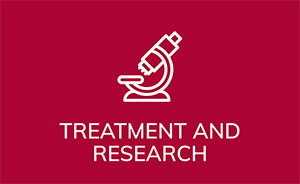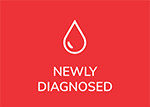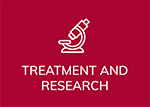In this video, Dr. Matthew S. Davids, MD, an Associate Professor of Medicine at Harvard Medical School and the Director of Clinical Research for Lymphoma at Dana-Farber Cancer Institute in Boston, is interviewed by CLL Society Co-Founder and Chief Medical Officer, Dr. Brian Koffman, MDCM, a retired family physician and a CLL patient. This video was recorded at the 62nd Annual Meeting of the American Society of Hematology, held virtually in December 2020. Dr. Davids specializes in CLL and serves on the CLL Society’s Medical Advisory Board.
The introduction of targeted non-chemotherapy for treating chronic lymphocytic leukemia (CLL) has revolutionized the care paradigm for many CLL patients, especially those with high-risk factors such as deletion (17p) or a TP53 mutation. Despite the advances enjoyed in the past seven years, some patients still achieve sub-optimal results. Extensive interest in exploring combinations of drugs was apparent during ASH 2020, as researchers strive for better responses.
The team at Dana-Farber felt that the combination of acalabrutinib (Calquence®), venetoclax (Venclexta®), and obinutuzumab (Gazyva®) would lead to deep remissions that would allow for time-limited treatment duration. The options for reaching deep remissions in R/R CLL are limited, so this could represent a future additional option in the CLL physician’s toolbox.
Takeaways:
- This trial enrolled 44 patients as of the study data cutoff date of July 24, 2020. Initially, this study included all previously untreated CLL patients; however, the trial later changed to only include patients with either deletion (17p) or a TP53 mutation. The median patient age was 63 (range, 41-78). Patients in this group included those with high-risk genomics, including deletion(17p) or TP53 mutation 17/44 (39%), deletion (11q) 12/44 (27%), unmutated IGHV 29/44 (66%) and complex karyotype (3 or more gene changes) in 9/44 (20%).
- With a median follow-up of 19 months (range, 6-26), 43 pts remain in the study (1 withdrew consent after six months due to GI symptoms).
- Of the 36 patients with at least 16 months of follow-up, the overall response rate (ORR) is 100%. Forty-three percent of patients had a complete response (CR), and 57% had a partial response (PR) in most cases due to small residual lymph nodes.
- After fifteen months of treatment, 84% of patients attained undetectable minimal residual disease (uMRD) in the blood, and 78% reached uMRD in the marrow.
- Of the ten patients with TP53-aberrant disease (deletion (17p) or TP53 mutation who completed 15 cycles to date, 4 had a CR, and 6 had a PR. Nine of 10 patients reached uMRD in the blood in this high-risk group, and 7 of 10 patients achieved uMRD in the bone marrow. Eleven patients with bone marrow uMRD discontinued therapy as allowed per protocol after 15 cycles. The median time off treatment for these patients is four months (range: 1-10).
- No patient has progressed to date.
- The most frequent non-hematologic adverse events (AEs) have been headache (80%), fatigue (77%), bruising (57%), nausea (45%), hypocalcemia (34%) [low blood calcium], rash (32%), and diarrhea (27%). Most of these adverse events were minor (grade 1 or 2).
- Hematologic toxicities were more severe (grades 3 or 4) with neutropenia (34%) [low neutrophils], thrombocytopenia (23%) [low platelets], and anemia (4.5%). Five patients with neutropenia required intervention with a granulocyte colony stimulating factor drug such as filgrastim or pegfilgrastim.
- Infusion-related reactions occurred in 11 patients (25%, 23% grade 1+2, 2% grade 3).
- One case of grade 3 atrial fibrillation (2%) and no cases of major bleeding or febrile neutropenia were observed.
- 6 patients required dose reductions, including 4 who reduced both acalabrutinib and venetoclax, and 1 patient each who reduced acalabrutinib or venetoclax alone.
Conclusions:
The AVO triplet of acalabrutinib, venetoclax and obinutuzumab is highly active, with 78% achieving uMRD (bone marrow) after 15 months of time-limited therapy in a frontline CLL population that included nearly 40% patients with TP53-aberrant disease.
No patients have progressed, with a median of 19 months follow-up.
The safety profile is favorable, with a 2% rate of ≥ Grade 3 infection and atrial fibrillation, and no tumor lysis syndrome (TLS) due to venetoclax, which was given with a more convenient 4-week ramp-up.
AVO is now being studied in a registrational Phase III trial ACE-CL-311 (NCT03836261) with the potential to define a new standard frontline therapy option for CLL patients. The link to find out where the study is available and more information: https://clinicaltrials.gov/ct2/show/NCT03836261.
Please enjoy this interview with Dr. Davids:
The link to the abstract presented at ASH 2020 is: https://ash.confex.com/ash/2020/webprogram/Paper139864.html
To learn more about clinical trials, in general, go to https://cllsociety.org/clinical-trials
Thanks for reading this summary and viewing this interview.
Stay strong; we are all in this together!
Thomas E. Henry III, MBA, RPh, CPh
Thomas E. Henry III is a Registered Pharmacist and CLL Patient. He is President and Senior Consultant for Burlington Consulting Associates, a company that provides consulting services to health systems nationwide. Tom is a CLL Society Medical Advisory Board member and strives to educate other CLL patients through his blog https://cllpharmacist.com/. He has a forty-two-year career as a licensed pharmacist and has served as Chief Pharmacy Officer at two Top-15 Comprehensive Cancer Centers, Moffitt (Tampa, FL) and Roswell Park Cancer Institute (Buffalo, NY).
Originally published in The CLL Society Tribune Q4 2021: Caregiver Edition.

















